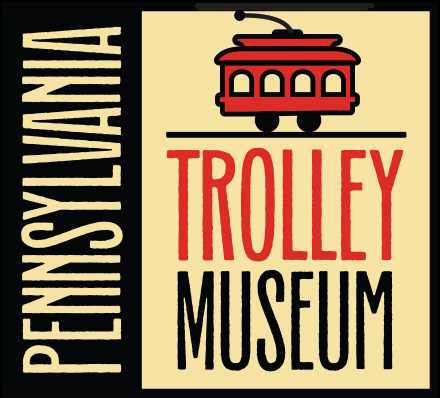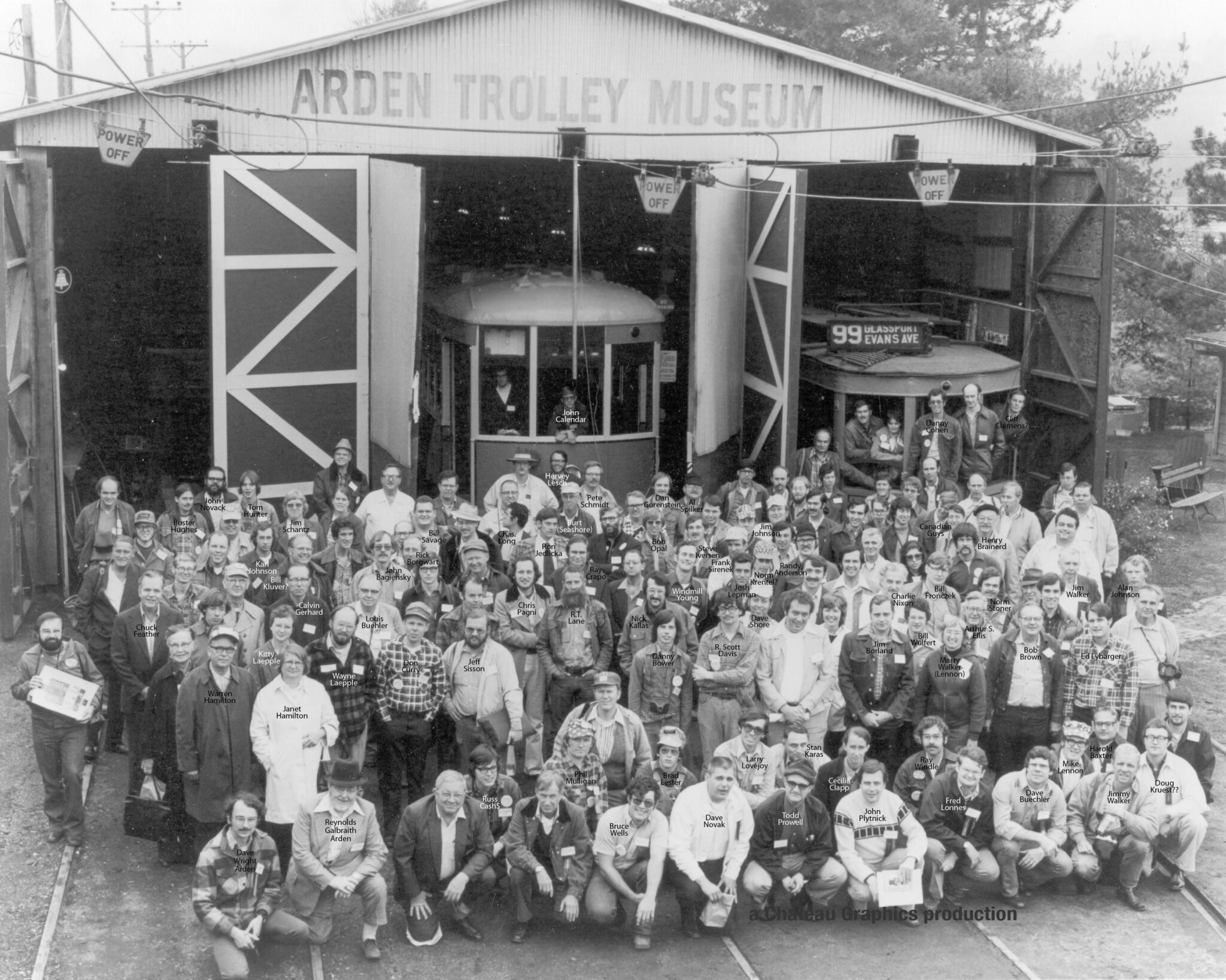Larissa Gula
Did you know that the Pennsylvania Trolley Museum (PTM) is 70 years old? Our official founding day dates back to 1954!
Earlier this year PTM members celebrated our anniversary in our new Welcome & Education Center. After guests enjoyed cake, streetcar rides, and even an evening photoshoot, Bruce Wells presented a special Trolleyology focused on the story of the PTM, from its founding to now.
In honor of this big milestone, we’re continuing to look back at our history through the decades. We’ve already written about the 1940s and 1950s – now it’s time to remember the 1960s and 1970s!
The 1960s – Out Of the Starting Gate
Establishing the Essentials
In the 1960s, the PTM – then known as the Arden Trolley Museum – was still being built and established by our founding organization, the Pittsburgh Electric Railway Club (PERC). Our first carbarn was constructed by hand between 1957 and 1961, providing shelter from weather and vandalism for the growing collection.
Power was also an essential area of focus. During these early days, a diesel generator could provide 600-volt direct current as needed. Obviously this was not a long-term solution, and so PERC members began construction of a substation in 1961; the new substation was then equipped in 1962. Members also organized to reconstruct overhead lines on the property (as the original overhead wire was stolen in 1956).
PERC’s hard work paid off on December 8, 1962, when volunteers shoveled up the winter snow and ran several cars with home-generated power. It was the first time we ran trolleys under their own power on the property since our 1954 founding day.
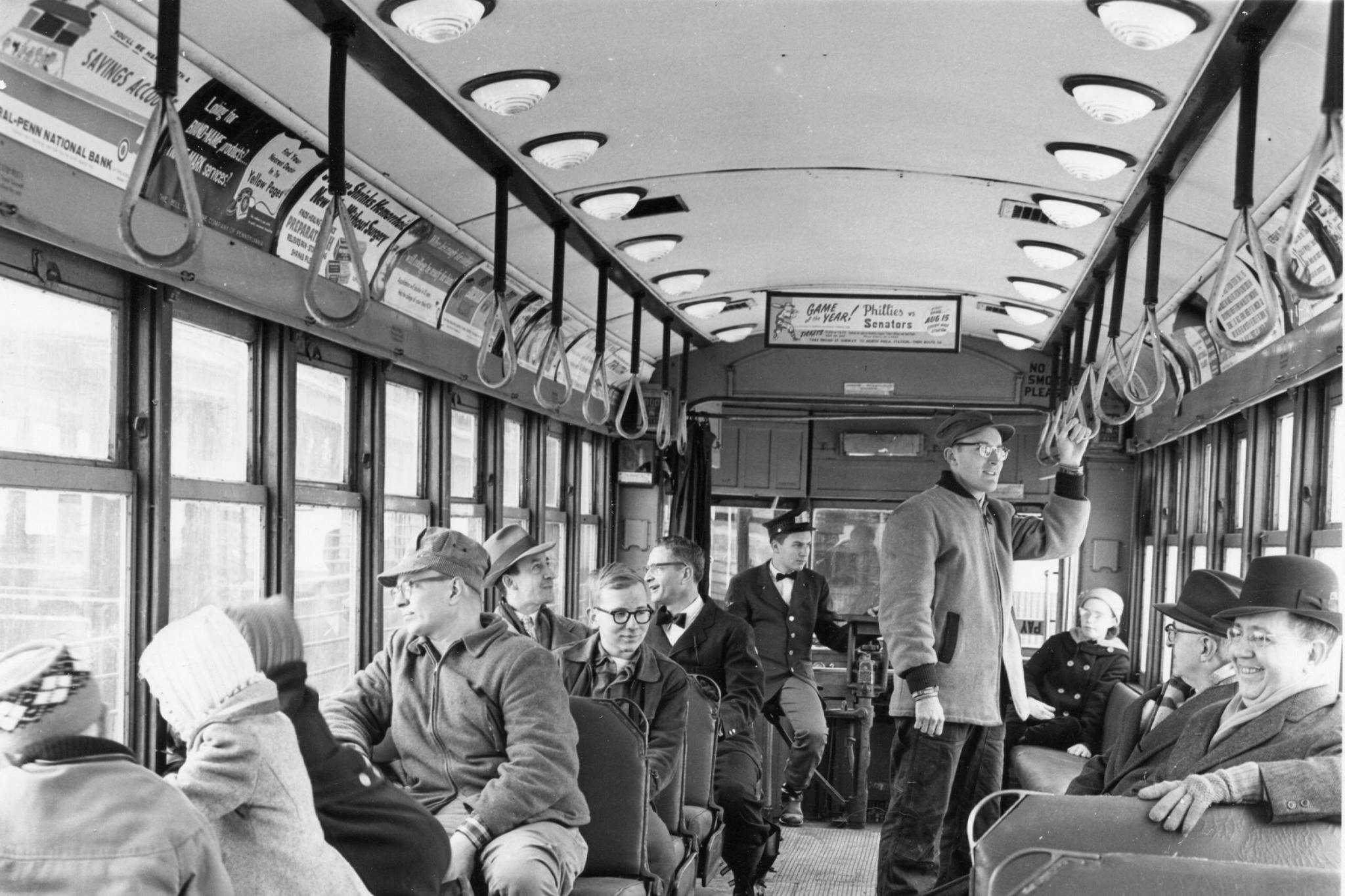
This 1962 photo from a public Open House event shows our early members and volunteers riding in 5326. Included in the photo are Reynolds Galbraith, Ray Chill, John Baxter, Rick Hannegan, and John Bagiensky
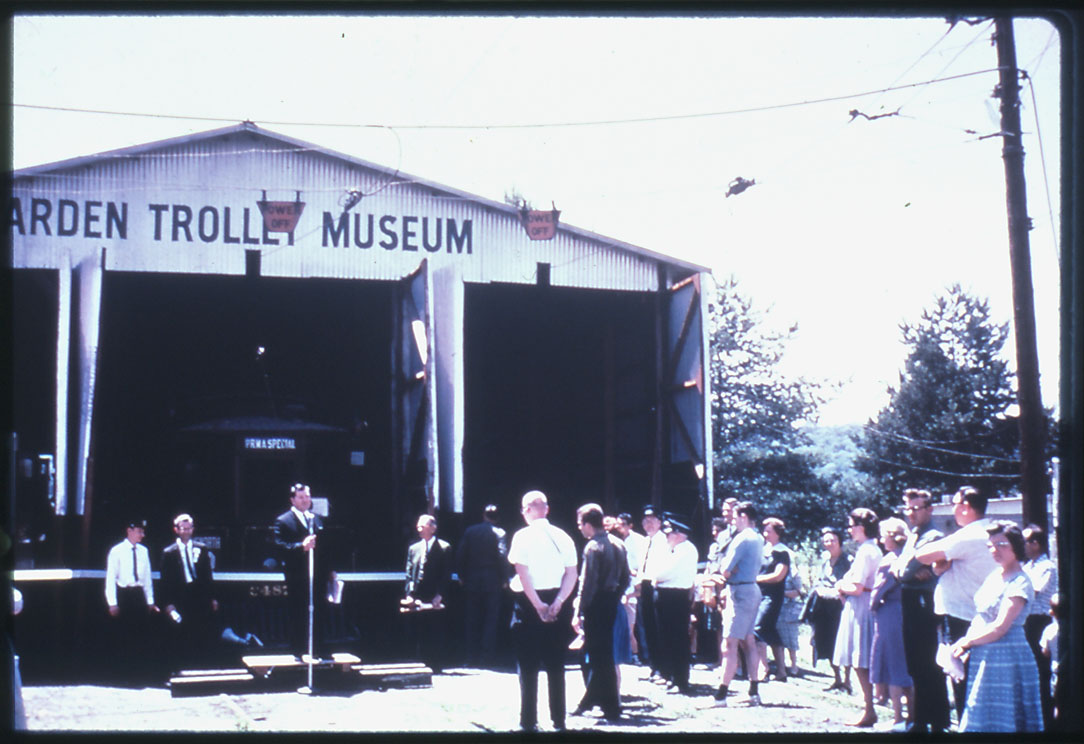
Opening Day
On June 23, 1963 – nine years after being founded – the Arden Trolley Museum celebrated its grand opening. Rather than cutting a ribbon, founders Bartley Brown and Reynolds Galbraith broke a ribbon while running Pittsburgh Railways 3487 out of the original Car House. (We continue to break ribbons with streetcars at major events and rollouts to this day!)
Washington County commissioners also attended the grand opening and used the time to officially dedicate the Arden Trolley Museum to its mission. Thanks to the efforts of the PERC, their collection of streetcars was no longer private – it was the basis for a living history museum and tourist attraction.
During and following opening day, rides were offered to people who visited the Arden Trolley Museum. Rather than charge admission, volunteers asked guests to pay a suggested donation while climbing aboard. Then – same as now – the ability to ride the collection (not just view it) was a unique feature in the museum industry.
Updating the Power Source
In 1965, the Museum pioneered the use of a modern solid state rectifier substation, with the installation of a unit originally built by Westinghouse for use in transit car testing. This substation connected directly to lines of the power company, greatly simplifying operating procedures.
Pioneering technology is rarely perfect of course; and so this early unit suffered technical difficulties. Fortunately, a larger and more advanced unit was purchased in 1969 – its 450-kilowatt capacity allowed the operation of several cars at once.
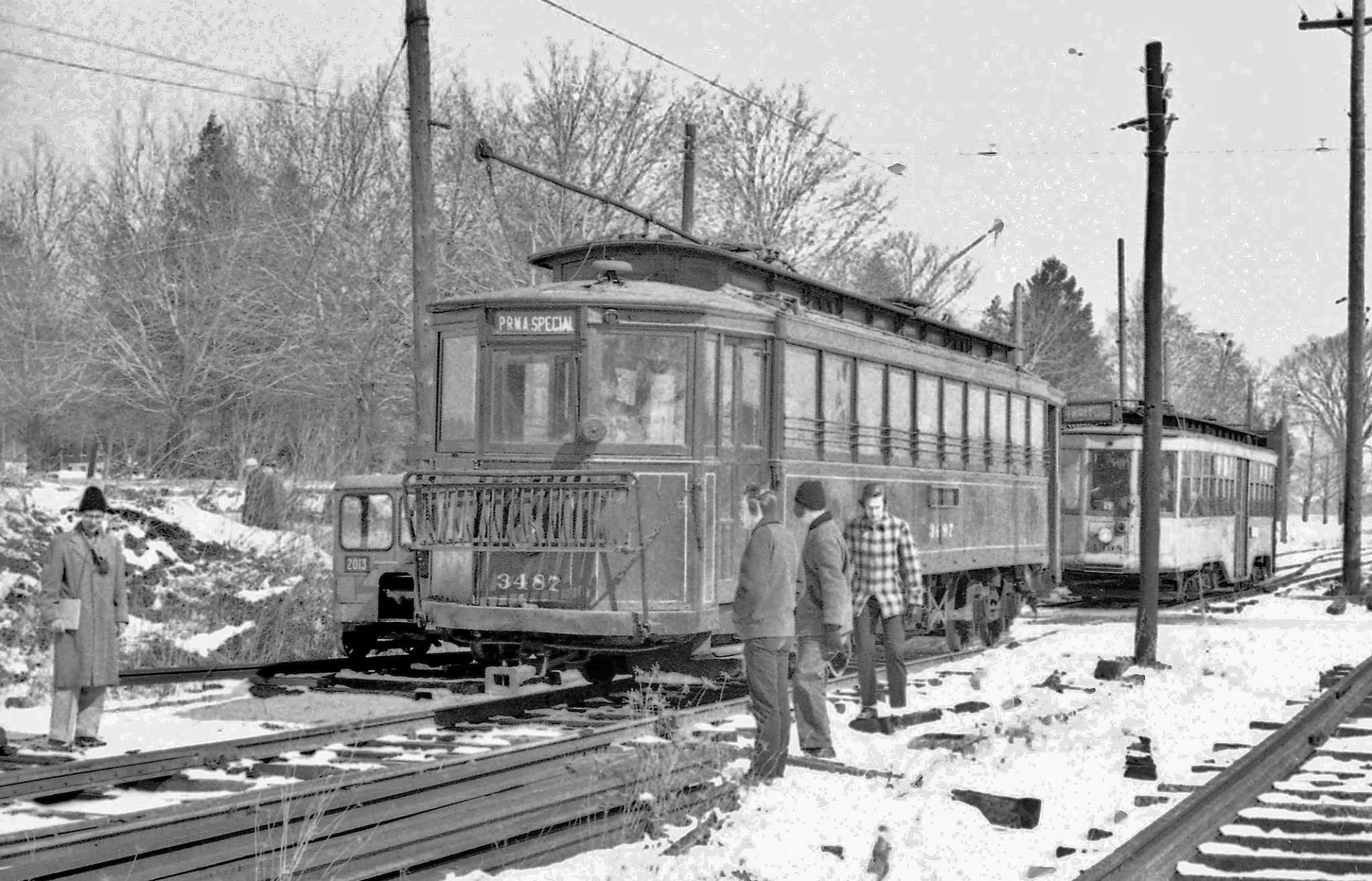
John Swindler photo
A Growing Collection
Throughout the decade, the Museum’s collection continued to grow with both transit and railroad acquisitions:
- Pittsburgh Railways 3487 and Pittsburgh Railways 4398, while acquired in 1956, did not arrive at the Arden Trolley Museum until 1960; prior to this, Pittsburgh Railways generously allowed PERC to store the cars at Glenwood Car House.
- In 1961, our first Presidents Conference Committee (PCC) car, Pittsburgh Railways 1138, joined our collection. At the time this was our ninth acquisition and was meant to take up the last available space in the original Car House.
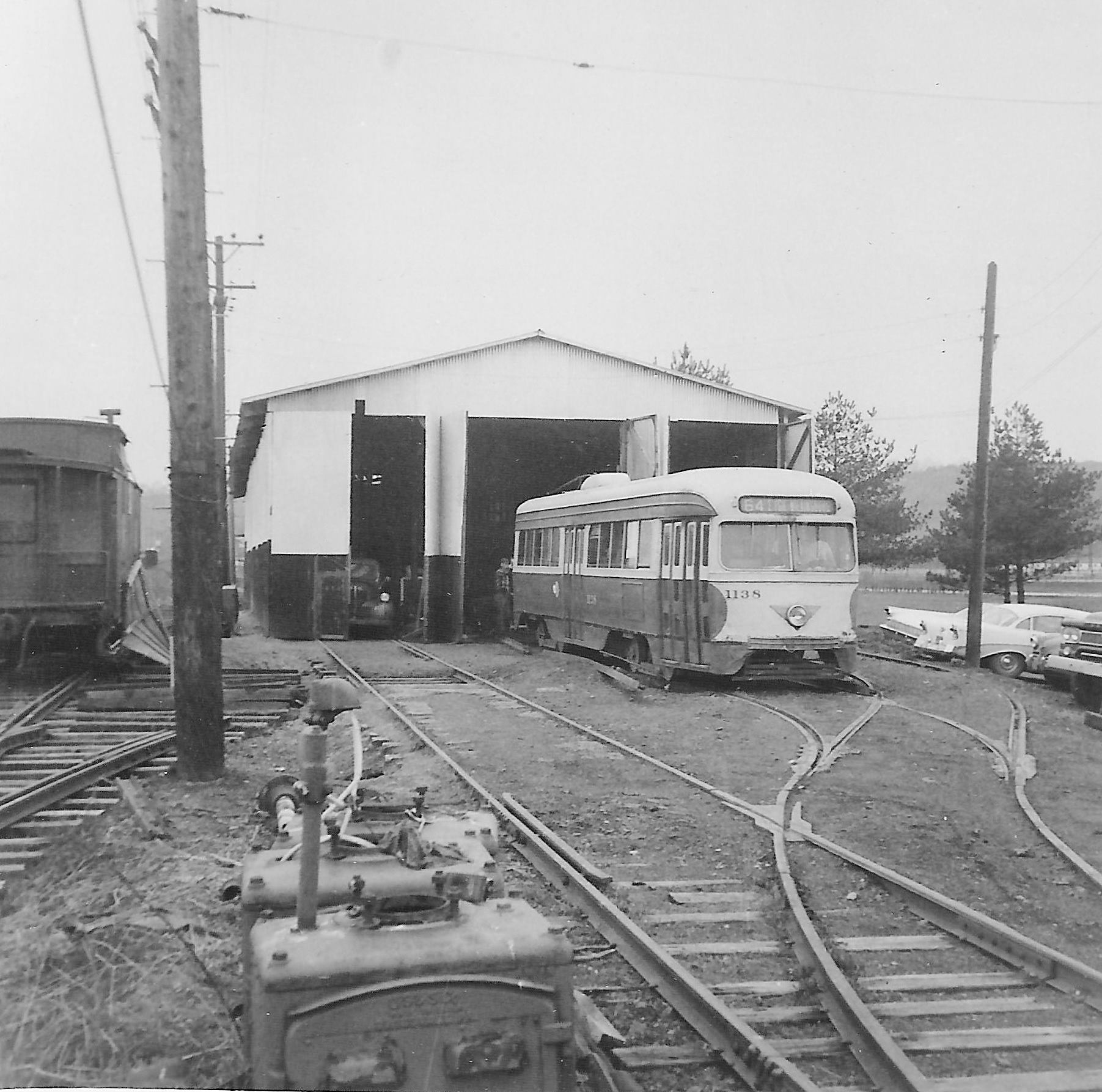
John Swindler photo
- In 1964, we acquired the “Streetcar Named Desire” – New Orleans Public Service 832. That year, forty New Orleans streetcars were retired from service following the closure of the Canal Street line. The cars were offered for $1 (plus transport costs) to museums nationwide. Our early members selected 832 specifically because it was featured in Life Magazine in 1947, when the play opened on Broadway.
- At this time our collection also included railroad equipment. In the mid-60s a steam locomotive was acquired from the Duquesne Slag Company, and a retired railroad coach was donated by the Bessemer & Lake Erie Railroad. Members and volunteers hoped to one day provide rides on a short stretch of track; and in the meantime, the Bessemer car allowed the Museum to open a gift shop and display area for visitors.
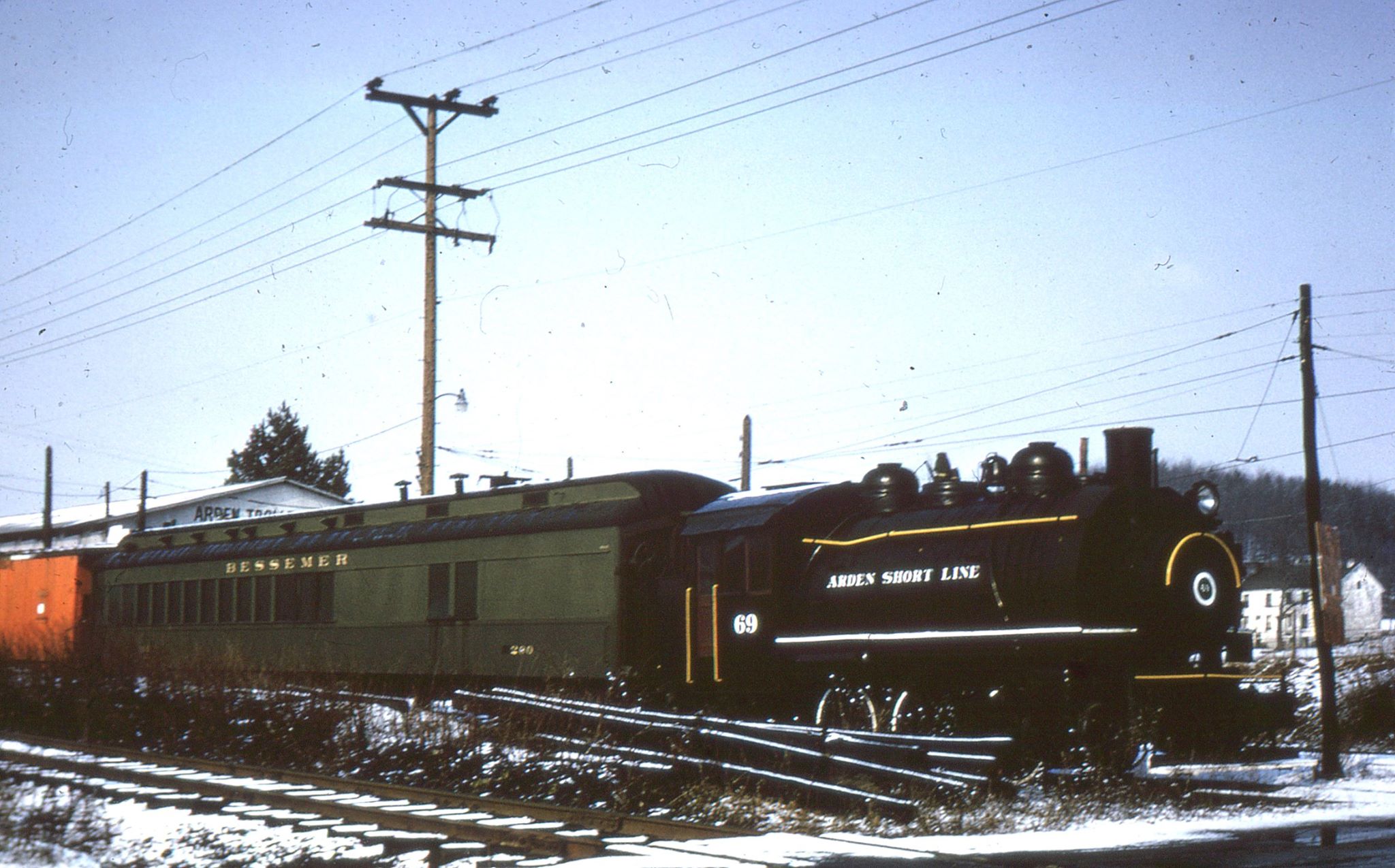
John Bagiensky photo
- Monongahela Valley Traction steeplecab electric locomotive 3000 was acquired in 1966, but would not arrive at the Arden Trolley Museum until 1968.
- By now our streetcar collection had truly outgrown the original Car House. Still the collection continued to grow, with the acquisition of Pittsburgh Snow Sweeper M37 (in 1967) and Pittsburgh Railways PCC 1467 (in 1968).
1970s – A Time of Growth
By 1970, the Arden Trolley Museum had expanded to a point where members and volunteers felt comfortable charging a fee to visitors. The visitor experience now included a short trolley ride (though it was growing longer thanks to a 1969 track extension to Main Street!), access to a small display area, and a chance to shop in a gift shop. An adult fare in 1970 was 50 cents per ride; children were 25 cents per ride; and an all-day pass was available for twice the per-trip price.
Admission was also a necessary source of revenue as the growing organization considered its next steps in this new decade.
Expanding Our Storage And Track
Almost two decades after its founding, there were concerns about the museum losing some of its rural character (as the area now included a new industrial park). Plans for an extension of the operating line across North Main Street (to a point near the village of Arden Mines) were developed in an effort to ensure and preserve the rural nature of the Museum experience. To acquire materials for this expansion, volunteers worked to remove over 100 tons of rail from Cat’s Run Wye on the Monongahela Railway (near Masontown, PA).
Plans were also developed for the construction of additional space needed to store, maintain, and restore the increasing number of cars in the Arden Trolley Museum’s collection.
We entered negotiations with Washington County officials to obtain the land needed for these plans. After several years of planning and discussion, approval of the carbarn project was received in 1975, while the right of way for the Arden Valley track extension was acquired in early 1977.
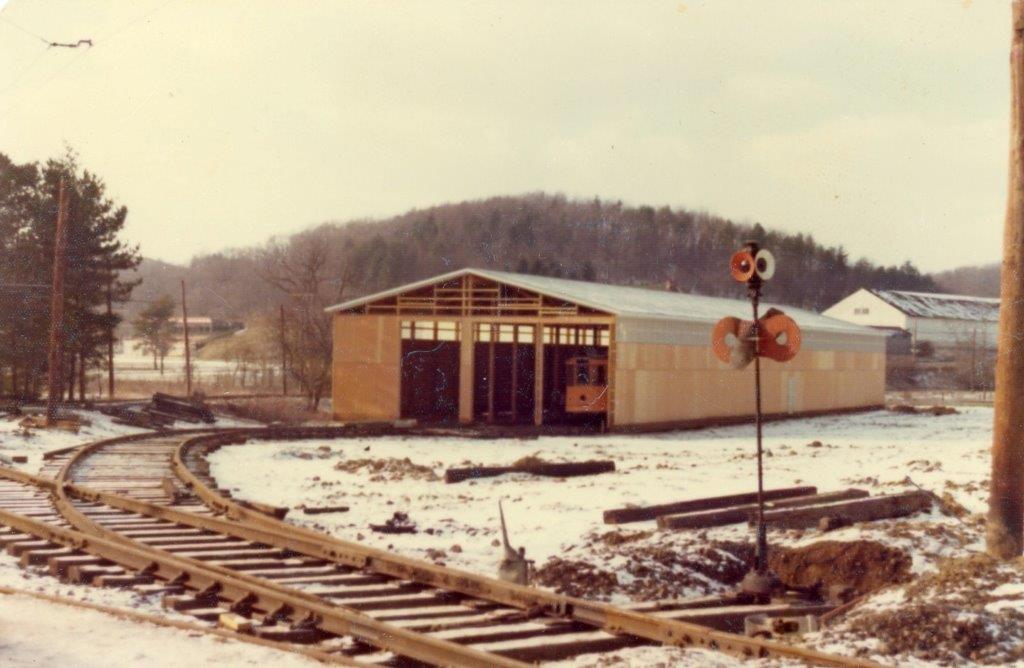
Tim Sposato photo
Construction of the new shop commenced in the fall of 1975. Unlike the founders’ carbarn, this shop was erected and framed by commercial contractors. So while the original Car House took four years to build, this second building was complete in just four months! The building was dedicated as the Galbraith Shop, bearing the name of cofounder Reynolds Galbraith; his generous contributions were instrumental in making the facility a reality.
Meanwhile, construction of the first segment of the Arden Valley track extension started in the spring of 1979; this project included work on the grade crossing at North Main Street. The installation of the crossing and expansion of track allowed trolley service to the parking lot gate of the Washington County Fair. That paved the way for us to start another favorite tradition: Park ‘N’ Ride services to the Fair.
The Collection Continues To Grow
By now it’s safe to say that we never let construction get in the way of acquiring a streetcar in need of a good home! And so our collection continued to grow through the decade:
- On Thanksgiving weekend in 1970, a group of enthusiastic volunteers traveled to Llanerch, PA. to load Red Arrow 66 onto a flat car for shipment to Arden. 66 arrived just before New Years, and would enter service in 1974 after it was restored and backdated to its 1949 appearance. 66 became – and remains – the heaviest passenger car in the collection.
- Federal Street & Pleasant Valley 101, a horsecar, was acquired from South Park in 1971 and taken to our neighbors at Meadowcroft Village for storage and display. This was an exciting acquisition for our early members, who had hoped to bring the horsecar home to the Museum for years!
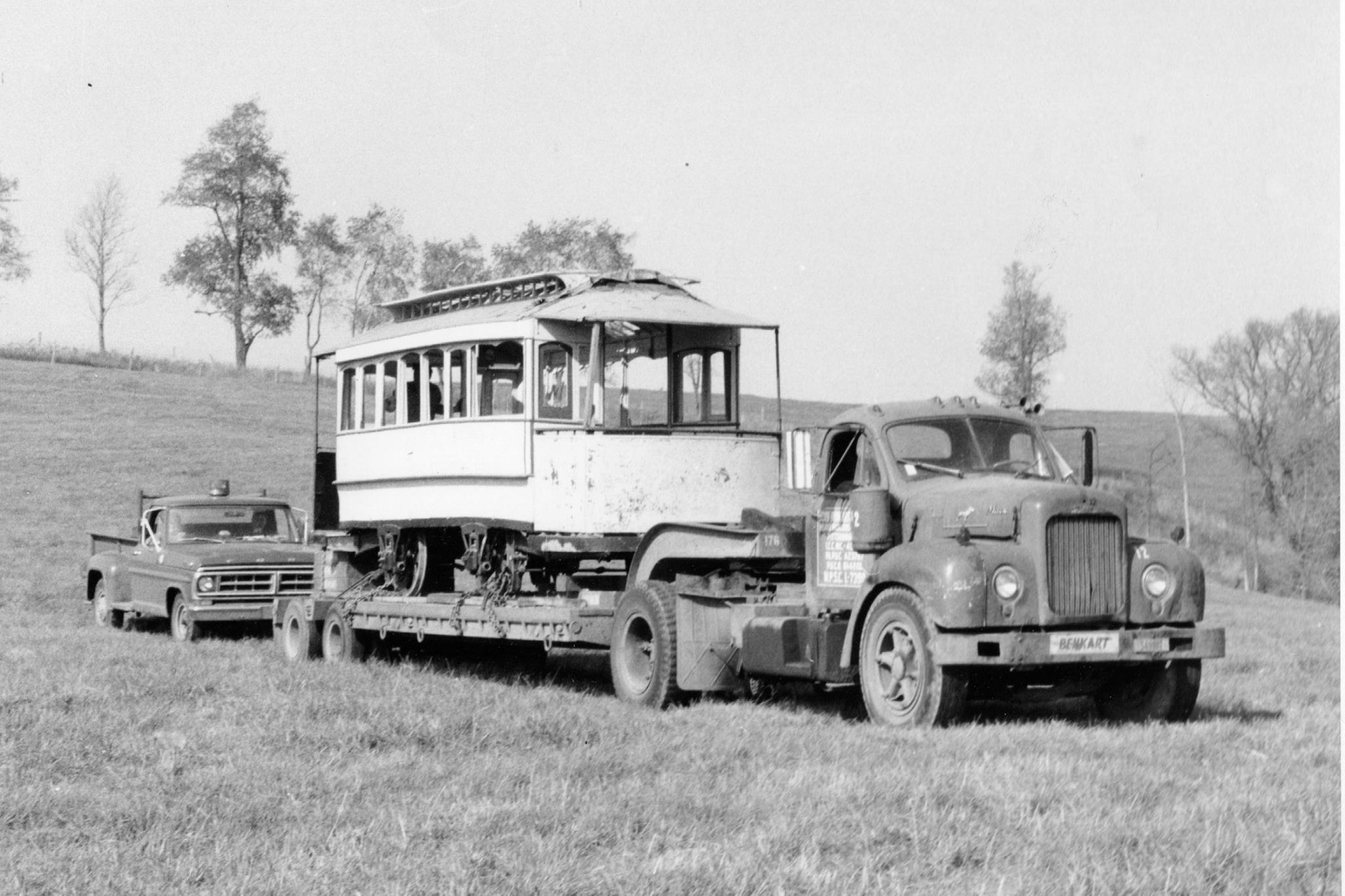
Bruce Wells photo
- Also in 1971, Butler-based group ARMCO Steel donated Armco Steel B73, a diesel locomotive built by Baldwin Westinghouse. At the time B73 helped to expand our railroad collection, offering a comparison to our steam engine as well as steeplecab electric locomotive 3000.
- Pittsburgh Railways Tow Car M200 was acquired the following year; at the time the goal was to restore it as a high-floor passenger car (as ATM members couldn’t have known we would acquire another high-floor car in the future).
- Beaver Valley Traction Company 1 came to us in 1972, although back then its number was M56. It is the only piece of surviving equipment from that company.
- In 1974 we acquired Boston Elevated Railway 3618 – a useful car that literally helped us build out the Museum over the years!
- Also in 1974, we brought home Monongahela West Penn 274; this interurban car had survived by being repurposed as a summer cottage in Southeast Ohio.
Other Interesting Milestones
We’d be remiss if we didn’t mention a couple other exciting events from the 1970s:
- In 1976, Pittsburgh Railways 3756 returned to Pittsburgh to participate in the nation’s bicentennial. This was the first of two trips 3756 made back to the city; its second trip was for the opening of Pittsburgh’s Light Rail system in 1987.
- Also in 1976, the Arden Trolley Museum hosted the Association of Railway Museums (ARM) conference, which was struggling to find a “home” to host the event that year. (See featured photo, top of page)
- And in 1977, the first restoration job began in the new shop on our horsecar! The car was rebuilt, cosmetically restored, and placed on display at Station Square in Pittsburgh.
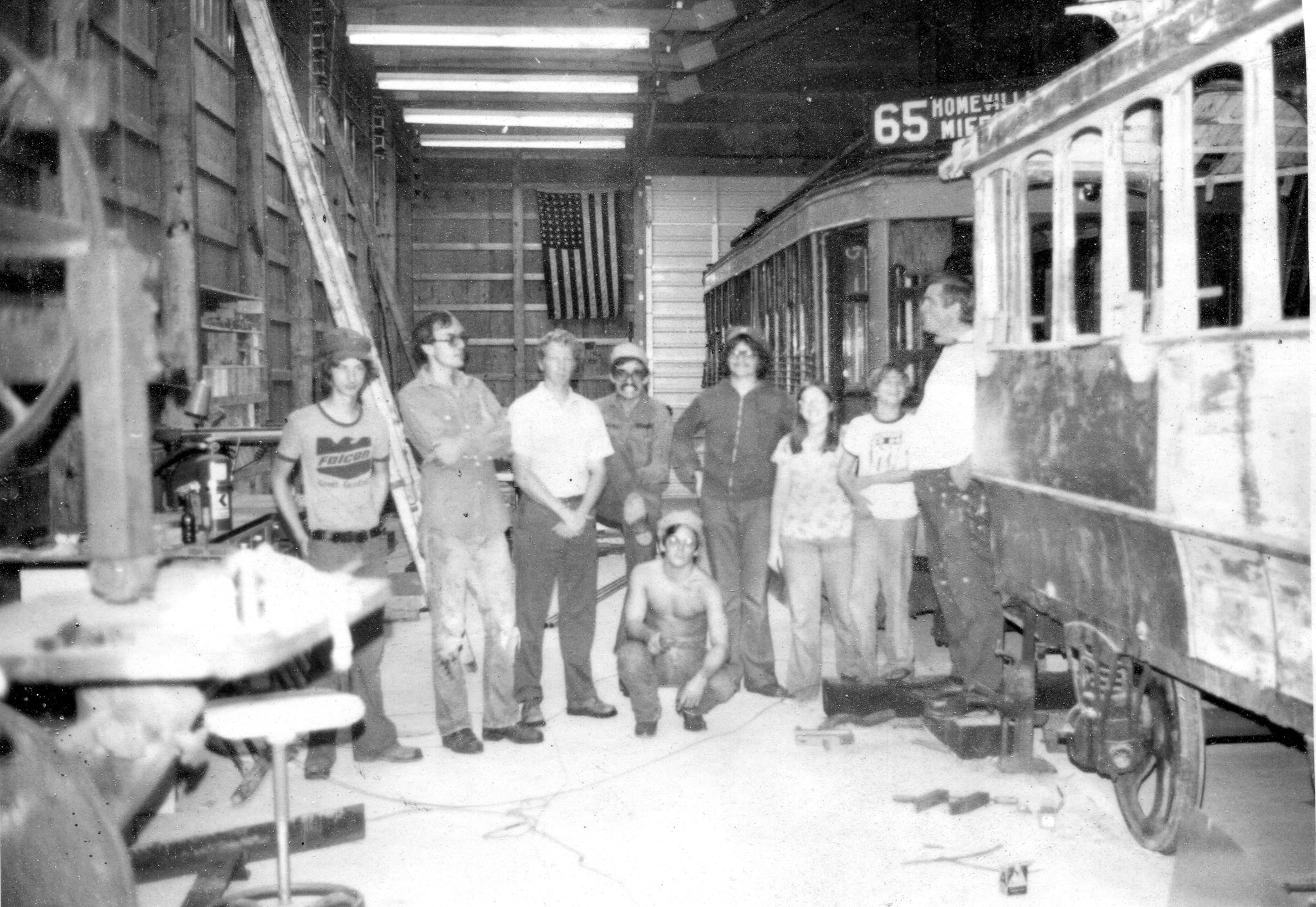
Bruce Wells photo
Two More Decades Down!
The 1960s and 1970s were pivotal decades filled with hard work and dedication from volunteers and members. Their efforts during these early years laid a solid foundation for our future. As we continue to celebrate our 70th anniversary this year, we proudly remember the people and the efforts that made our current visitor experience and preservation efforts possible!
Throughout 2024, we plan to look back on additional memories and milestones at the Pennsylvania Trolley Museum. In the meantime, we invite you to watch Bruce Wells’ Trolleyology presentation if you haven’t already. His excellent presentation includes additional memories, details, and photographs that we couldn’t include here!
